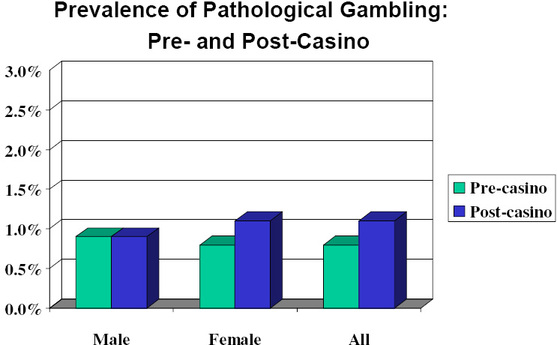Common sense might dictate that bringing a casino into a community should raise local levels of compulsive gambling and that this directional hypothesis can be tested with a "before and after" analysis. But the opportunity to perform "before and after" research on the impact of casino gambling is rare. The introduction of casino gambling to a new geographical area is a relatively infrequent event, giving researchers few cases to study. In addition, such studies require methodological parity; that is, pre- and post-casino data collection methods must be comparable and samples drawn from the same population. Furthermore, even if a significant increase or decrease is observed, without comparision groups no conclusions can be made regarding causation, since the prevalence of compulsive gambling in the study population may be changing independent of the casino gambling. In spite of these difficulties, Govoni, Frisch, Rupcich, and Getty (1999) undertook the task of interviewing residents of Windsor, Ontario before and after the opening of Casino Windsor in 1994. The data presented herein represent the findings from the first phase of their multi-year study.
The authors conducted telephone interviews with 2,682 randomly selected adults. Included in the survey instrument were the SOGS, questions about gambling expenditure, and other gambling and demographic items. The same survey was administered two years later, after Casino Windsor had been open for one year. The second sample was demographically comparable to the first, and consisted of 2,581 individuals. Changes in levels of problem and pathological gambling are presented in the figures below. 


Although the figures appear to show directional changes in the levels of problem and pathological gambling, these differences fail hypothesis testing and are not statistically significant (see chart above). Thus, in spite of intuition, introducing a casino to Windsor did not result in an increase in compulsive gambling. These results may not be generalizable to other communities. And, it should be remembered that these findings do not necessarily hold true for the introduction of other forms of gambling. Finally, one year may not be enough time for discernible changes to occur. Nevertheless, the present study demonstrates the importance of using scientific methods as a means of testing common sense assumptions.
Source: Govoni, R., Frisch, G.R., Rupcich, N. & Getty, H. (1999). First year impacts of casino gambling in a community. Journal of Gambling Studies, 14(4), 347-358.
The WAGER is funded, in part, by the National Center for Responsible Gaming, the Massachusetts Department of Public Health, the Andrews Foundation, the Addiction Technology Transfer Center of New England, the Substance Abuse and Mental Health Administration Services, and the Center for Substance Abuse Treatment.




